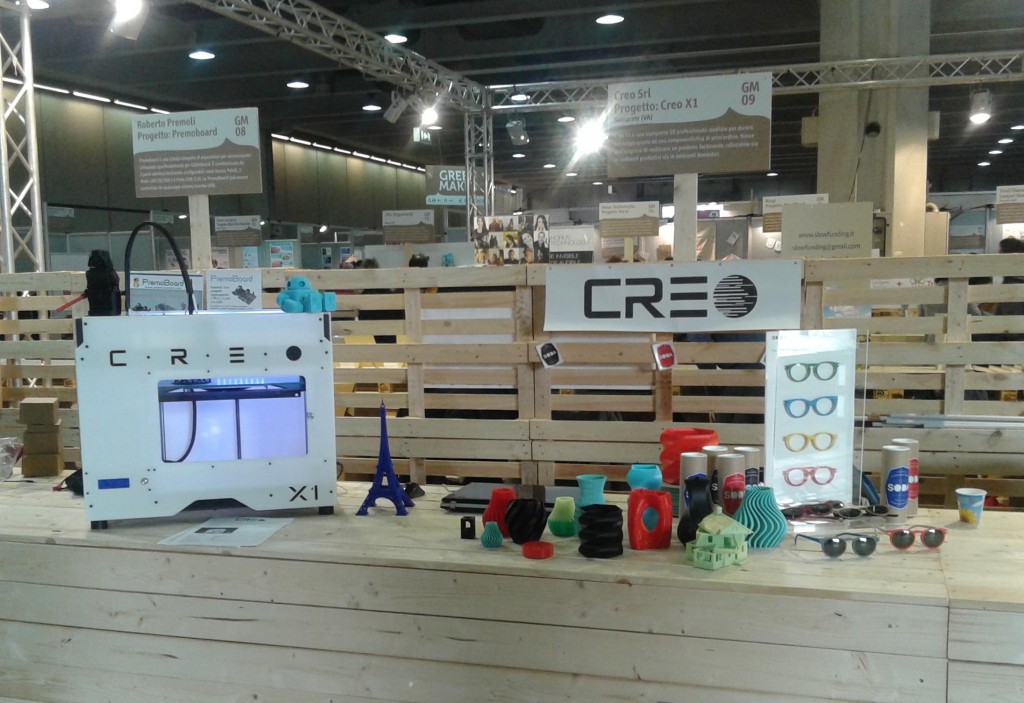Corrado Doggi, the “mad visionaire” (as he likes to describe himself) behind the newly announced Creo X1 3D printer, is not really mad. His madness is the reflection of a combination (and conflict) between his architectural/design background and his knowledge of mechanical systems and rational industrial dynamics. The new prosumer-class 3D printer reflects and finds its defining traits in this contrast.
The machine has been developed to be extremely solid and reliable, with straight laser-cut lines and an aluminum and stainless steel frame. And, yet, it did not shy away from certain aesthetic features, such as a lit-up white body or the possibility to insert and hide away the filament spool. After seeing it in action, to me the most significant feature of the Creo X1 3D printer is the fact that it is incredibly silent, something that will be appreciated by both professional and nonprofessional users.
Creo represents a first step into the world of additive manufacturing for Corrado, who has also contributed content for 3DPI in the past, and his business partner, Fabrizio Rosa – who runs a large metrology machine manufacturer. And this step was not taken lightly. The machine is intended to cater both to large, industrial users that need quickly replaceable components and smaller studios or makers that need a solid and reliable 3D printer with a large build size at an affordable (though still undisclosed) price.
“Almost two years ago, while I was looking for components to build a drone robot, I ran into a video of a 3D printer and it was love at first sight,” says Corrado. “Just like in a movie, I decided I would seek out 3D printing and a long love story began, culminating now with the upcoming launch of the Creo 3D X1.” To do this Doggi partnered with Rosa and with marketing expert Riccardo Montoli, in order to form a complete team. The X1 represents only the first step into the additive manufacturing landscape; however, Corrado is a firm believer in the potential of AM at all industrial levels.
“Paradoxically, even those who already use 3D printing are convinced this technology has severe limitations; however, nothing could be farther from the truth,” Corrado says, “In terms of production, we need to move away from the concept of serial mass manufacturing and start producing only what, where,and when it is needed. For example, in the automotive sector, a mechanic may have requests to supply a muffler, twenty handles, two carburetors that he will be able to manufacture at the same time, if made of the same material. Transporting the raw materials in powder form for SLS processes allows for further optimization.”
To help raise awareness about the enormous potential benefits of 3D printing to industrial production, Doggi and Rosa have contributed to found AITA, the Italian Association of Additive Technology Manufacturers. The association seeks to help users understand the differences between home and industrial 3D printing process, but the union between these two faces of manufacturing is part of Creo’s strategy for the X1. Its development and testing was, in fact, carried out through collaborations with local fablabs/makerspace, such as TheFabLab and Yatta in Milan.
Weighing in at 35 Kg, the Creo X1 is not an easy fit for a living room, but it sits well inside a fablab on a work desk. It has an optimal print volume to size ratio of about 1:2 and it can build objects as large as 366 x 240 x 200 mm (14.4″ x 9.4″ x 7.9″) with a single extruder (with the X size reduced to 326 mm for a dual extruder). It has been tested to print with nylon and PET, as well as PLA and ABS. It means to allow prosumers to print larger size final objects and large manufacturers to access the convenience of direct manufacturing, bringing a the “mad vision” of distributed production and cold, rational, economic convenience.



